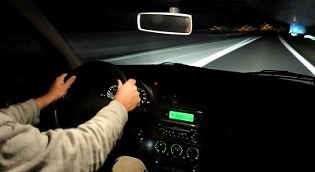
Shorter days, fatigue, compromised night vision, rush hour and impaired drivers are some of the risks we face when driving at night. These risks become especially pronounced moving into the weekend, with fatal crashes peaking on Saturday nights, according to NSC analysis of NHTSA data.
When Daylight Saving Time ends – for 2020, that's 2 a.m. Sunday, Nov. 1 – many people will find themselves spending more time driving in the dark. Depth perception, color recognition and peripheral vision can be compromised in the dark, and the glare of headlights from an oncoming vehicle can temporarily blind a driver.
Even with high-beam headlights on, visibility is limited to about 500 feet (250 feet for normal headlights) creating less time to react to something in the road, especially when driving at higher speeds.
What should you do to combat darkness?
- Aim your headlights correctly, and make sure they're clean
- Dim your dashboard
- Look away from oncoming lights
- If you wear glasses, make sure they're anti-reflective
- Clean the windshield to eliminate streaks
- Slow down to compensate for limited visibility and reduced stopping time
Compromised Night Vision
Night vision is the ability to see well in low-light conditions. As we age, we have greater difficulty seeing at night. A 50-year-old driver may need twice as much light to see as well as a 30-year-old. At age 60 and older, driving can become even more difficult, according to the American Optometric Association. Some older drivers also may have compromised vision due to cataracts and degenerative eye diseases.
Fatigue
A National Sleep Foundation poll says 60% of adults have driven while they were tired, and another 37%, or 103 million people, have fallen asleep at the wheel. Of those, 13% say they fall asleep while driving at least once a month, and 4% say they have caused a crash by falling asleep while driving. The reasons are many – shift work, lack of quality sleep, long work hours, sleep disorders – and it doesn't only happen on lengthy trips.
These staggering numbers are backed up by a report by NHTSA that 100,000 police-reported crashes are a result of driver fatigue. Most crashes or near-misses happen at the times you would expect drivers to be tired: 4 to 6 a.m., midnight to 2 a.m. and 2 to 4 p.m., according to NSF.
Drowsy driving puts everyone on the road at risk. Losing two hours of sleep has the same effect on driving as having three beers, and tired drivers are three times more likely to be in a car crash if they are fatigued.
The National Sleep Foundation offers this advice:
- Get seven or more hours of sleep a night
- Don't drive if you've been awake for 16 hours or more
- Stop every two hours to rest
- Pull over and take a nap if you're drowsy
- Travel during times you are normally awake
Rush Hour
Evening rush hour (between 4 and 7 p.m. weekdays) is a dangerous time to drive due to crowded roadways and drivers eager to get home after work. In winter, it's dark during rush hour, compounding an already dangerous driving situation.
How can you make it home safely during rush hour?
- Don't be an impatient driver; slow down
- Stay in your lane and beware of drivers who dart from lane to lane
- Even though the route may be familiar, don't go on autopilot; stay alert
- In unfamiliar areas, consult a map before you go and memorize your route
- Don't touch your phone, eat, drink or do other things that are distracting
Impaired Drivers
Nearly 30 people die every day in crashes that involve a driver impaired by alcohol, according to the Centers for Disease Control and Prevention. Drivers impaired by prescription medicines and other drugs increase that number significantly. Impaired drivers are most frequently on the road after dark – particularly between the hours of midnight and 3 a.m. on weekends.
While drunk driving has declined by about one-third since 2007, the number of drivers under the influence of drugs has increased. Between 2013 and 2014, 22% of drivers tested positive for a drug that would cause impairment, according to a roadside survey conducted by the National Highway Traffic Safety Administration. NHTSA also found that the prevalence of THC (found in marijuana) among drivers on weekend nights increased 48% since 2007, from 8.6% of drivers to 12.6%. Many states have not yet updated their impaired driving laws to address this growing problem.
Source: Driving at Night. (n.d.). Www.Nsc.Org. https://www.nsc.org/road-safety/safety-topics/night-driving
